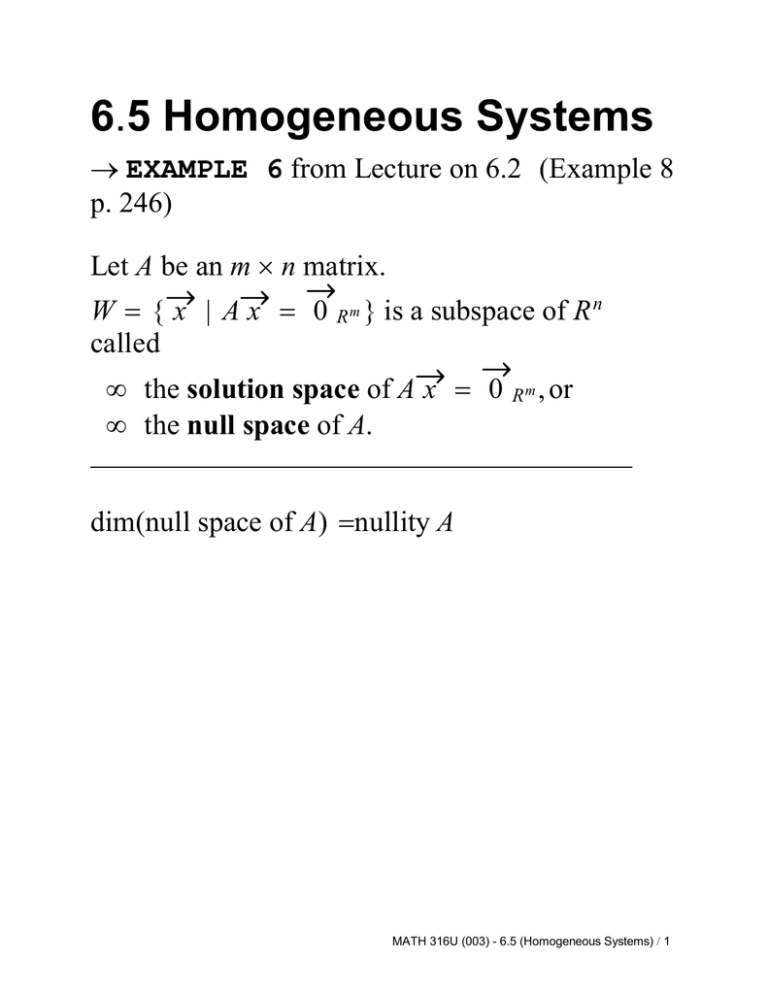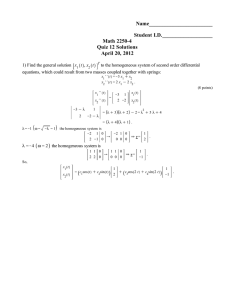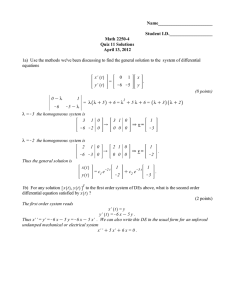6.5 Homogeneous Systems
advertisement

6.5 Homogeneous Systems
→ EXAMPLE 6 from Lecture on 6.2 (Example 8
p. 246)
Let A be an m × n matrix.
W = {x | Ax = 0
called
Rm }
is a subspace of R n
• the solution space of A x = 0
• the null space of A.
R m , or
dim(null space of A) =nullity A
MATH 316U (003) - 6.5 (Homogeneous Systems) / 1
EXAMPLE 1
Find a basis for W = { x | A x = 0 } where
1 2 0 3 1
2 3 0 3 1
A=
1 1 2 2 1
.
3 5 0 6 2
2 3 2 5 2
The augmented matrix of the homogeneous
system has the reduced row echelon form
1 0 0 −3 −1 | 0
0 1 0
3
1 | 0
0 0 1
1
1
2
0 0 0
0
0 | 0
0 0 0
0
0 | 0
| 0
The solution:
MATH 316U (003) - 6.5 (Homogeneous Systems) / 2
x 4 = s (arbitrary)
x 5 = t (arbitrary)
x 1 = 3s + t
x 2 = −3s − t
x 3 = −s − 1 t
2
can be expressed in a vector form:
x1
3s + t
x2
−3s − t
x3
=
−s −
x4
s
x5
t
=s
1
2
t
3
1
−3
−1
−1
+t
− 12
1
0
0
1
MATH 316U (003) - 6.5 (Homogeneous Systems) / 3
The vectors v 1 = (3, −3, −1, 1, 0) and
v 2 = (1, −1, − 12 , 0, 1)
• span W and
• are linearly independent.
Therefore, {v 1 , v 2 } forms a basis for W.
The nullity of A is 2.
MATH 316U (003) - 6.5 (Homogeneous Systems) / 4
→ p. 277: Procedure for finding a basis for the
solution space of a homogeneous system
Ax = 0.
• Solve the given system using Gauss-Jordan
reduction.
• If the solution is unique
x = 0
then the solution space is { 0 } and has
dimension 0.
• If some of the unknowns have arbitrary
values s 1 , …, s p (since the corresponding
columns in the reduced row echelon form do
not contain leading entries), then express the
solution as
x = s1 v1 + s2 v2 + ` + sp vp
In this case, {v 1 , v 2 , …, v p } forms a basis for
the solution space. The space has dimension
p.
→ Example 1 p.278
MATH 316U (003) - 6.5 (Homogeneous Systems) / 5




